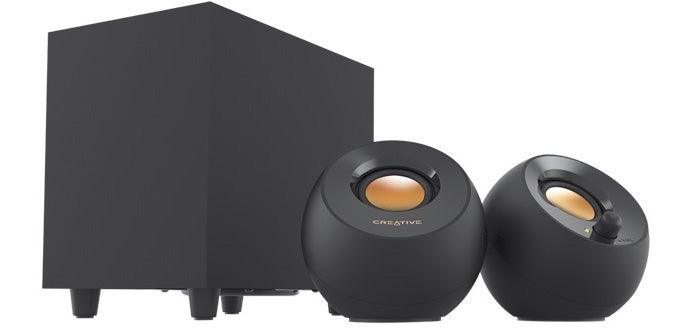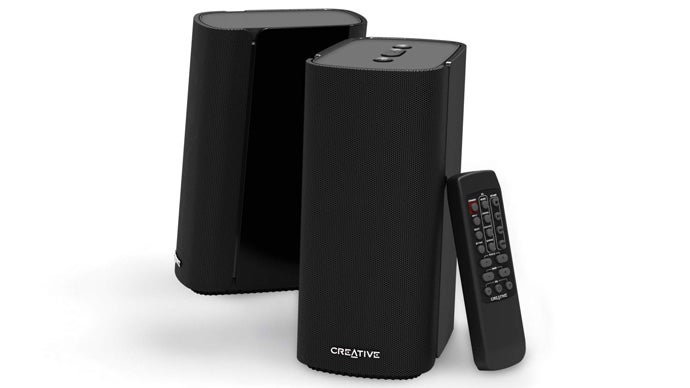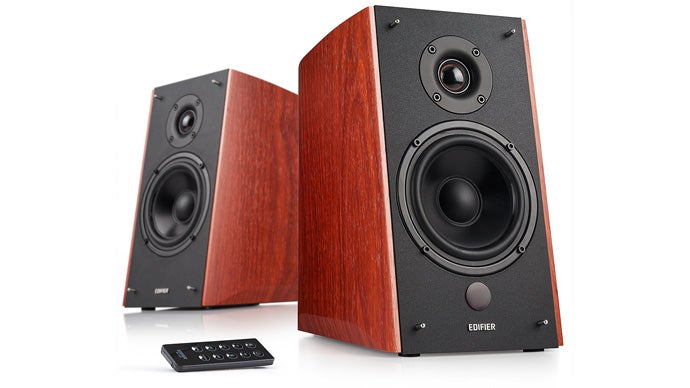Each recommendation here is suitable for use with laptops and desktop PCs, and both the mid-range and high-end picks also include Bluetooth and optical inputs to work with games consoles, smartphones and tablets too. We’ve also included a single soundbar recommendation, and may look to expand this category in future. For the purposes of this article, a budget speaker is under £50/$50, a mid-range speaker is around £100/$100 and a high-end speaker is sub-£250/$250. We’ve also picked a premium option at around £600/$600. Of course, it’s possible to spend hundreds or even thousands on all kinds of speakers and sound bars; these definitions are a shorthand for this article alone rather than an industry-wide standard. If you want to spend more, feel free to do your own research on the many options available and find the speaker that fits your needs!
Best budget computer speakers Best mid-range computer speakers Best high-end computer speakers Best mid-range 2.1 computer speakers Best high-end 2.1 computer speakers Best gaming soundbar Best premium computer speakers Frequently asked questions
Without further ado, let’s get into the recommendations. In the UK, the older Creative A250 is also a great shout at around £26, but we couldn’t find these (at a reasonable price) in the US. In terms of sound quality, the lack of a subwoofer does mean you’re missing out on a bit of low-end oomph, even with the bass ports on the rear. However, this limited range is made up for by the excellent clarity provided by the T100s. Mids and highs are well reproduced with rich tones. Overall, a strong option at this price point if connectivity and convenience are important to you. If you’d prefer something that fits a more overtly gamer aesthetic, then the Logitech G560 is a 2.1 system with RGB lighting at around the same price range. The Edifier R2000DB include Bluetooth, optical and two 3.5mm inputs, providing plenty of interfaces to keep all of your devices connected at once, plus a (fiddly) remote control to make sense of it all. Altogether, it’s a compelling package at a very reasonable price point. If you can’t stretch to the R2000DB, check out the slightly cheaper Presonus E4.5. The speakers sound great, producing rich sound across a wide frequency range with detailed highs and surprisingly tight bass from the subwoofer. With 200W of power on tap, you can easily fill even a large bedroom or living room with thunderous sound. There’s a dedicated bass knob right next to the volume on the left speaker, so you can quickly turn up or down the bass as necessary, plus a 3.5mm aux input and a 3.5mm output for headphones. This 2.1 setup requires more wiring than the 2.0 options we’ve highlighted elsewhere on the page, but if you have the luxury of adding noticeable bass to your music without annoying your family, flatmates or neighbours, then the ProMedia 2.1 Bluetooth is an excellent argument for a dedicated sub. If you don’t need the Bluetooth support, the original ProMedia 2.1 is an even better value option. There is a feeling here that you are paying for these gaming-oriented features - RGB don’t come cheap - but there are plenty of thoughtful touches that make these speakers feel worthwhile. Being able to fine-tune their orientation with proper tilt options, lighting that properly illuminates your wall but also turns off with your computer or a double-tap of the multi-function button, and an easily accessible, glancible volume wheel all count for a lot here. The speakers also look nice, with a pleasantly rounded design and a band of lighting around the base to complement what’s shooting out of the back. As well as the Arena 7, SteelSeries has also produced the Arena 3 (a 2.0 system sans RGB) and the Arena 9 (a 5.1 surround sound system). We’re testing the former presently and will update this coverage once we’ve reached a verdict. For the Arena 7 though, there’s plenty here to suggest this new take on the traditional 2.1 setup eclipses trendier PC gaming soundbars - although the Klipsch 2.1 system above is a better value choice overall. The answer, for Creative, is RGB - but thankfully, it doesn’t stop there. They’ve made the soundbar less wide than most, in order to fit neatly under a 27-inch gaming monitor, although this decision has left the soundbar taller than most too. Perhaps more importantly, there are ‘scout’ and ‘battle’ modes that are designed to make sounds from distant enemies louder and aid directionality, respectively. Beyond this, you’re free to tweak the EQ to your liking in the app. These modes, and the general SXFI surround sound simulation, work well enough but I ultimately preferred the standard setting with these modes disabled. I am a habitual ‘default/flat’ settings user though, so if you prefer surround sound modes then you’ll still appreciate their inclusion here. Modes aside, sound quality here is on par with other soundbar-plus-sub combos in a similar price range, with impressive levels of power, a warm sound signature and just a bit of missing detail dragging things downward. This sort of setup is something that you can adjust with EQ alterations and feels more acceptable in a soundbar than in speakers, given the more TV-focused use case. The only true complaint I have regards usability with a PC; the sound bar disappears completely from Windows when it automatically turns off, so it has a tendency to surprisingly alter which device is being used. This can be worked around by using a different output method than USB, but then you lose out on app controls, so it’s not ideal. However, if you’re the type to often be listening to music, this is less likely to bother. Despite the increase in (physical) volume, these active speakers retain the easy usability of the R2000DB, with convenient coaxial, balance, USB (up to 24/192kHz), Bluetooth 5.0 (w/ aptX) and optical inputs. All of these inputs can be selected using the provided remote control. Rather than being joined by a cable, the left speaker connects to the right one wirelessly, which makes it easy to position them - although both still need plugging into mains power. I didn’t run into any issues with the wireless connection, but it would have been nice to have this an option regardless. Overall, we were incredible impressed with the S3000PRO in our testing. Given their sound and their versatility, that makes them very easy to recommend if your budget does stretch to that nearly £600 mark. There are many resources online for speaker recommendations at all price ranges; we particularly recommend Head-Fi and BudgetAudiophile. Of course, we’re open to reviewing more expensive options too; stay tuned! What are the best speakers for competitive gaming? For competitive gaming, we recommend sticking with headphones as these provide better clarity, imaging and noise isolation. We have a selection of the best gaming headphones in 2021 right here. What are the best RGB speakers? Probably the Razer Nommo Pro, but RGB really isn’t necessary for audio equipment. Why only three choices? We’ve just started - stay tuned for new recommendations as we have time to test them!






